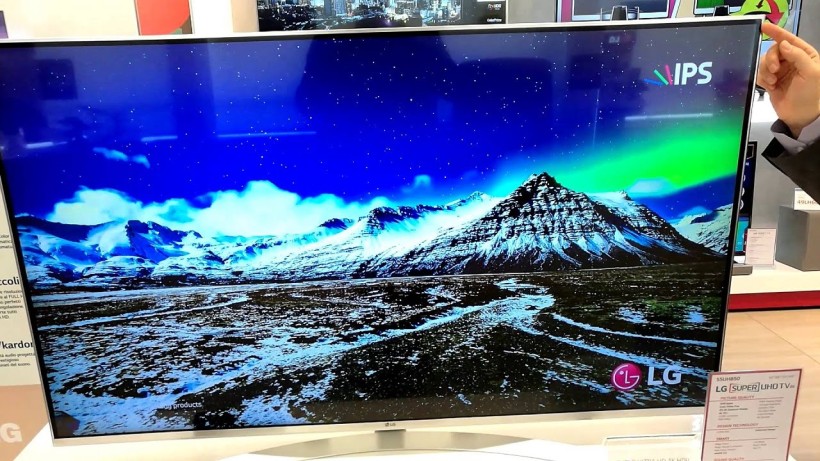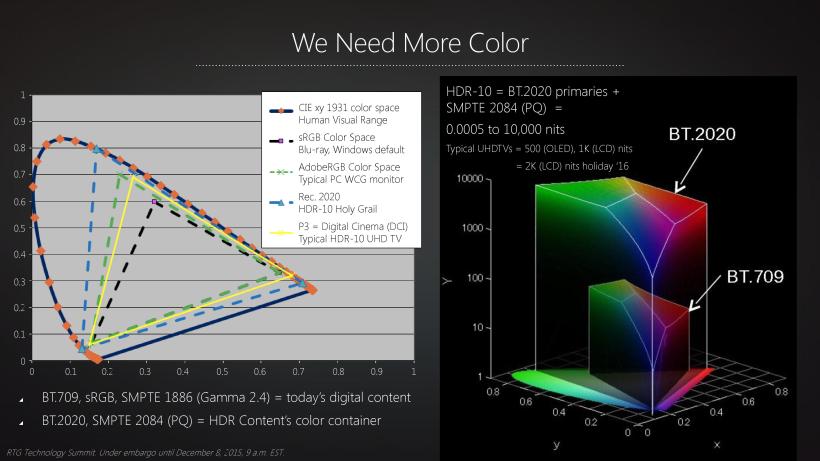
Photo credit: LG Corporation
October Update: Wired just released this buying guide
FYI: https://www.wired.com/2016/10/4k-hdr-television-buying-guide/
With the annual ritual of the Consumer Electronics Show coming up in CES January 2017 (including CE Innovation Awards), the excitement is building among consumer electronics aficionados to learn how much progress has been made this year. During CES 2016, nearly every TV manufacturer introduced high dynamic range (HDR explained by Digital Trends) televisions in both 4K and 8K range configurations. Several companies including Samsung, Panasonic and Sony introduced their first UHD Blu-ray models at a $500 price point though the media is expensive yet is superior to streaming due to superior picture and sound quality. There is now HDR on Android phones but photography specialists urge Snap-chatters to learn to use the HDR setting selectively. So, is it just a better resolution TV and Blu-Ray player combo- ho hum? – NO!
Digital Trends explains HDR, “Imagine a TV picture that is more like what you see in real life. One with spectral highlights closer to what you see when the sun gleams off the surface of a lake, or when the stars and moon are especially bright in the sky. Imagine getting to see the exact same shade of green you see on Los Angeles’ highway signs on a TV for the very first time (did you know TVs haven’t been able to faithfully produce that color?) or a shade of red envisioned by a movie director that is so bright and exotic, you’re convinced you’ve never seen it before. HDR makes that possible.”
Some models highlighted by Trusted Reviews, CNET, and Consumer Electronics.
So the key in looking at these HDR TVs is to see (and hear) them first-hand to see whether you consider the picture quality dynamic in terms of contrast, color and compelling ! They all are conforming to the 360 degree design and direct LED lighting that are the industry standards, it seems…The 4K TV broadcast standard ATSC 3.0 will eventually be the new digital broadcast standard for over-the-air TV reception at which point the tuner in your current TV will no longer work so that will force an upgrade cycle.

Photo credit: AMD Radeon Technology Group
Samsung (65″, 75″, 85″. 88″, starting at $1899): The 9500 Series was well received at CES16 but the price points escalate rapidly though Trusted Reviews has a positive view on the ’65” model). The ’65” boasted a UHD Premium logo and native resolution of 3,840 x 2,160 pixels, while its peak brightness is capable of exceeding 1,000 nits in this edge LED lit model. Some consumers have been concerned by privacy issues as the Samsung TVs like this one connect automatically to up to 200 “Smart Things” in your home.
LG (60″, 65″, 70″ and 79″, starting at $1,049): The LG UH7700 features a thin, stylish design with a unique curved stand. Its display has a great viewing angle, making it easier to see from the sides of a room. Latency and motion blur are especially low, always a plus for gaming. Amazon has the 65″ for just $1440 for you football fans!
Sony (45″, 55″, 65″, starting at $1,299): Sony HDR Series X850D sports a high refresh rate and wide viewing angle but has a greater input lag and a less crisp picture quality than the Samsung models so far. Sony’s X850D has a strong overall Rtings score of 7.7. The X930D competes better with the Samsung offering at at $2K price point.
Sharp TV US (now controlled by Chinese firm Hisense): Hisense, which now has a CES presence that rivals that of LG, Panasonic, and Samsung, has rated in the lower half of the Consumer Reports rating scales. Under a Sharp license, Hisense presented at CES a 65-inch “ULED TV,” the Hisense 65H10B, a quantum-dot-based UHD set.